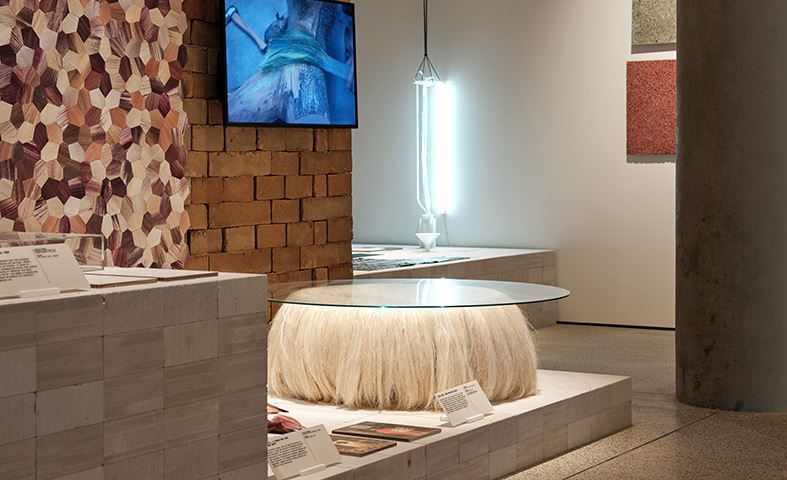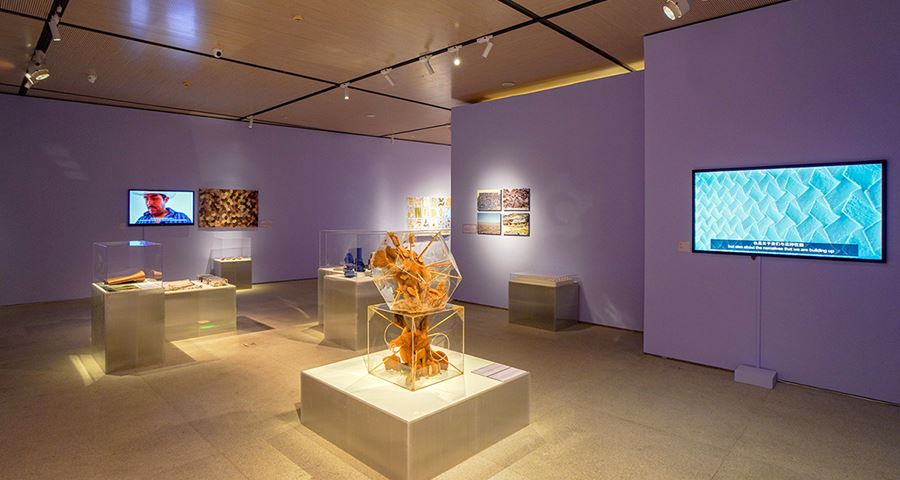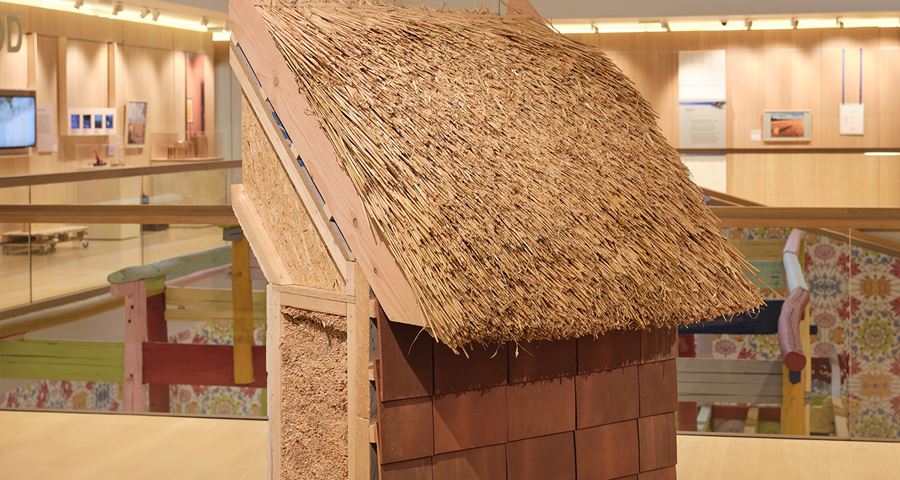Design for a greener future
Q&A with Elise
This Q&A introduces Elise Foster Vander Elst, our Head of Exhibitions & Environmental Impact Lead, and the museum's ongoing work focusing on the green transition.

Elise Foster Vander Elst © Felix Speller for the Design Museum
Q: Can you tell us about your work as Head of Exhibitions and Environmental Impact Lead at the Design Museum? [How do they overlap?]
I oversee the exhibition and displays delivery team. With our colleagues in the Curatorial department, we develop and produce up to ten projects a year at the museum in Kensington. To do this, we work with designers and contractors to transform galleries into new environments. We build walls, ceilings, showcases and plinths, and ship objects around the world to present them to our audiences in London. Over the last two years, we’ve become increasingly aware of the carbon footprint of our activities and have been looking to reduce their impact.
As Environmental Impact Lead (and with support from our fantastic Environmental Impact Manager), I am leading a shift in how we approach the development of temporary exhibitions to reduce Scope 3 emissions. Within the Design Museum more widely, I’m responsible for supporting culture change, encouraging colleagues to intentionally consider the planet when making decisions in their area. Zooming out further, my role is to advocate for a more sustainable way of thinking within the cultural sector, with a view to catalysing change across UK museums.
Q: How do you work together with the museum’s Future Observatory?
We are collaborating very closely with the Future Observatory team. Their work on the green transition has inspired us all to think differently about our activity. More specifically, they have provided funding – in partnership with the Arts and Humanities Research Council (AHRC), which is part of UK Research and Innovation (UKRI) – to develop a new Exhibitions Toolkit which includes a guide with tips and decision trees, and an exhibitions-specific carbon calculator. We also worked with them to produce a report supported by the Department of Culture, Media and Sport, aimed to:
– Identify the significant barriers to reducing the carbon impact of temporary and touring exhibitions
– Suggest tools and strategies to overcome those barriers
– Recommend opportunities for future research and development
Q: What is the responsibility of museums to respond to the planetary emergency?
Museums have always been places for research, development and knowledge exchange. They have a unique opportunity to speak to a variety of audiences through exhibitions and outreach programmes and can communicate complex ideas in meaningful and experiential ways. In recent years however, we have seen that they can do so much more than this. My colleague Justin McGuirk, Director of Future Observatory, put it very elegantly in a recent blog post – "what if they drove innovation and behavioural change? What if they aimed for policy change? What if they could fund critical research? What if they showed an urgent sense of purpose?".
It is our responsibility to actively embed more sustainable thinking into the DNA of our institutions. This can be hard when funding is limited and organisations are still bouncing back from the pandemic, but the reality is that the world is headed for climate catastrophe without urgent action. We can no longer separate the climate movement from our day-to-day activities, be it in our personal or professional life.
Q: How does the Design Museum plan to lower its environment impact?
The biggest cause of the climate crisis is the burning of fossil fuels like coal, oil and gas. Luckily, we have alternatives such as renewable energy. At the museum we procure our electricity from sources backed by Renewable Energy Guarantee of Origin (REGO). As our Waste Age: What can design do? audit revealed, energy supply is the most important step to reducing emissions. Although we are reliant for gas for some areas of the building operations, if the Design Museum galleries used the national average electricity for the Waste Age: What can design do? exhibition, the project would have used over six times the amount of CO2e.
In terms of our programme, it’s true that the museum develops exhibitions that are inherently temporary and asks people to travel to visit them. However, by presenting projects that raise awareness of the issue (like Waste Age) or explore possible solutions (such as How to Build a Low-Carbon Home) we can showcase new materials, technologies and systems designers are developing in pursuit of a more sustainable future for everyone.
Our learning team have been developing an exciting partnership project called Growing Together, which is rethinking and reshaping the Dame Sylvia Crowe Garden on the museum grounds. A cohort of volunteers share stewardship of the site, exploring design and horticulture as catalysts for positive social change. The project reuses materials from exhibitions, is developing planting schemes for a changing climate and is guided by the RBKC Biodiversity Action Plan.
On the exhibitions production side, we aim to reduce the environmental impact of our activity through careful decision-making relating to how we transport objects and how we design and build our exhibitions. We will spend 2023 gathering CO2e data for our exhibitions and displays and will start introducing carbon budgets next financial year (whereby we set a target of CO2e used with the aim to reduce over time).
Our retail operation is constantly striving to improve the sustainability credentials of their supply chain. They aim for all their products to support at least one of their 8 Climate Conscious values (sustainable production, vegan, circular/recyclable, made in the UK, material from sustainable sources, organic, reduces waste, focus on workforce welfare).
Meanwhile, our internal Environmental Impact Working Group is developing a new strategy to reflect the museum’s wider ambitions. On a very practical level, we are also reviewing our policies to ensure they’re in line with our goals.

Waste Age exhibition – Sisal Table made from agave leaves left over from tequila distilleries by Fernando Laposse, 2019
Q: Can you tell us about the development of the Design Museum’s toolkit for more sustainable exhibitions and displays?
In 2021 we presented a major exhibition entitled Waste Age: What can design do?. Throughout the development of the project, we worked with URGE Collective who encouraged us to challenge our assumptions and gather data to understand more about the footprint of this exhibition.
URGE Collective also conducted a Life Cycle Assessment of the exhibition which was enlightening. After the exhibition closed, we felt it was important to capture our leanings and share them with colleagues in the sector who were keen to hear about our work in this area and change their own practices. We included these recommendations in our Exhibitions Toolkit. It features a guide for designers and project teams, and an impact model. The aim of these documents is to help with decision-making, to ensure everyone is asking the right questions and holding each other accountable from the beginning to the end of a project.
Q: In what ways has the Design Museum’s approach to designing exhibitions changed since its inception?
We’re now very settled in our Kensington home (we moved to this building from Shad Thames in 2016) and have a good knowledge of our exhibition spaces. We have developed strategies to ensure temporary walls last for several exhibitions and sharpened up our processes so that reuse of materials is efficient and viable.
Since 2022, we have also changed how we approach procurement of contractors and how we brief designers (we do not have an in-house design team). Check out the ‘Commissioning design’ section of our guide to find out more about the material decision trees we are using to decide which materials to prioritise.
Q: What are some of the biggest challenges that the Design Museum faces in meeting its environmental goals?
The Design Museum has an active touring programme and is committed to engaging internationally to support creativity beyond borders, showcasing the most important design from across the world, and broadening our horizons and of those who visit our exhibitions in London or abroad. However, this work does of course have an environmental impact. We are currently researching ways to work with international partners to reduce the impact of this aspect of our work, but it is not straightforward.

Material Tales, touring exhibition
Q: What is the role of design in the age of the climate emergency – is it the solution or the problem?
Ah the great question! I am an optimist. I believe good design will save us. If you don’t believe me, come and visit our latest display on How to Build a Low-Carbon Home to see for yourself.

How to Build a Low-Carbon Home exhibition
Q: Is greater collaboration needed between museums to develop more sustainable practices?
Absolutely – the will is there. The Design Museum is in contact with so many museums, galleries and cultural institutions in the UK and abroad who are all ready for change. We are collegiate and creative as a sector, and I know that when we work together, we are greater than the sum of our parts.
One example is the South Kensington Zero Emissions Nature Positive group which we belong to. The Design Museum has joined forces with the 21 members of the Exhibition Road Cultural Group (including Natural History Museum, Science Museum, V&A, Imperial, Royal Albert Hall) to deploy our world-leading creativity and expertise in science and the arts to develop collective approaches to tackle the climate crisis. Working together, we aim to show real leadership and accelerate action through collective understanding, collective action and collective voice.
Q: How can a museum, as an organisation, contribute to a green transition for positive impact?
We have a plan! Visit futureobservatory.org to find out more.
Further reading
Design Museum resources
Future Observatory at the Design Museum
Gallery Climate Coalition (GCC)
Julie’s Bicycle
– Resource hub – exhibitions case studies
– Guides, podcasts, webinars, research
– Environmental Impacts of Digital Cultural Production
Museums Association
– Climate resources bank
– Reading list
– Museums for Climate Justice
Barbican Centre
Ljubljana Design Biennale (BIO27)
Rethink podcast
Plan your visit
Open seven days a week
Our permanent collection, Designer Maker User, is a free display and is open daily from 10.00 to 17.00. No pre-booking is needed to access our free displays. Pre-booking is recommended for paid exhibitions and events.